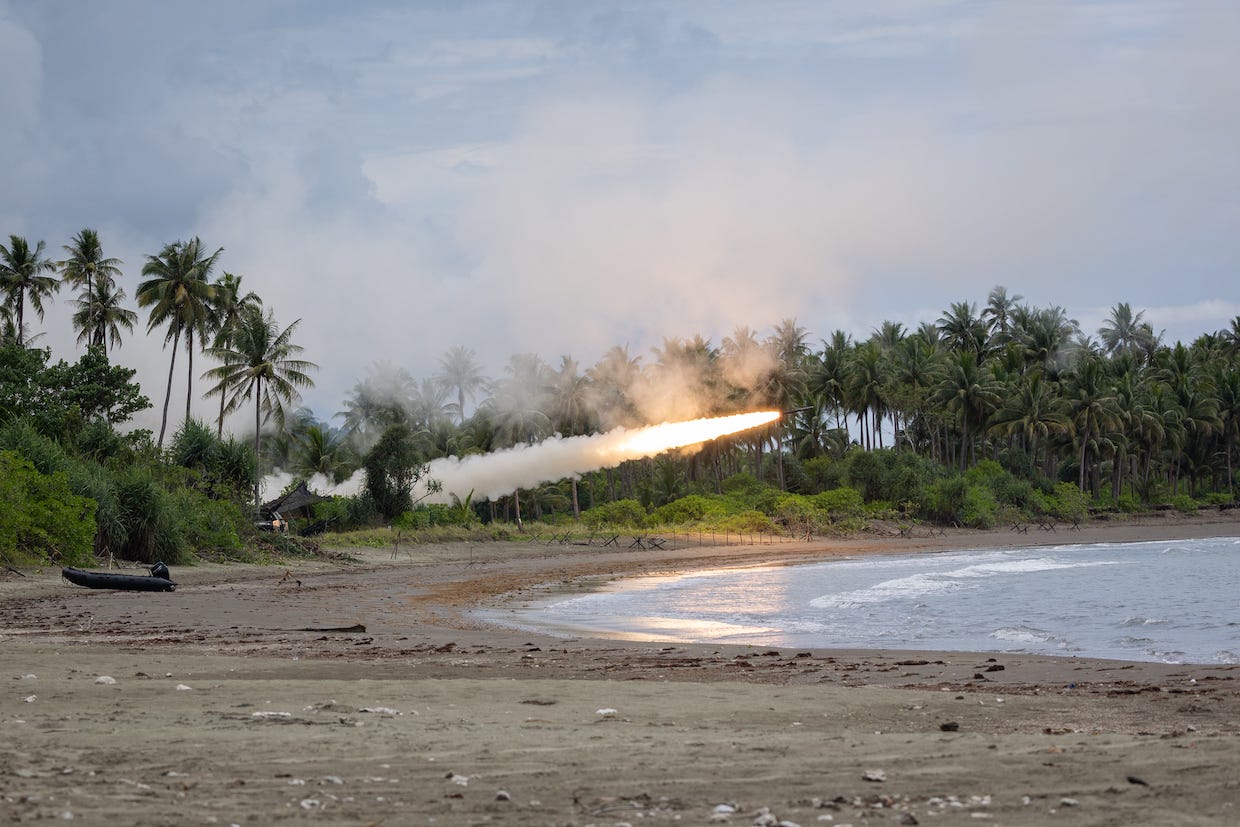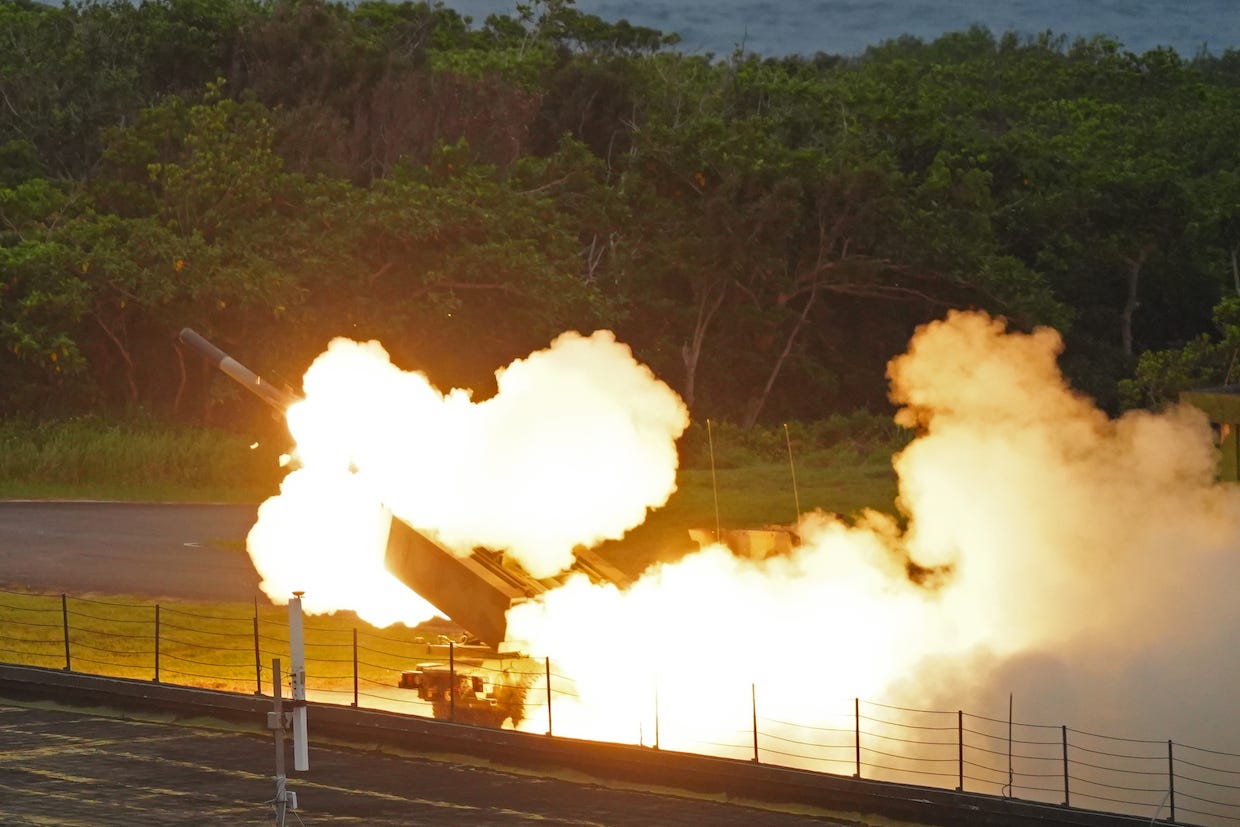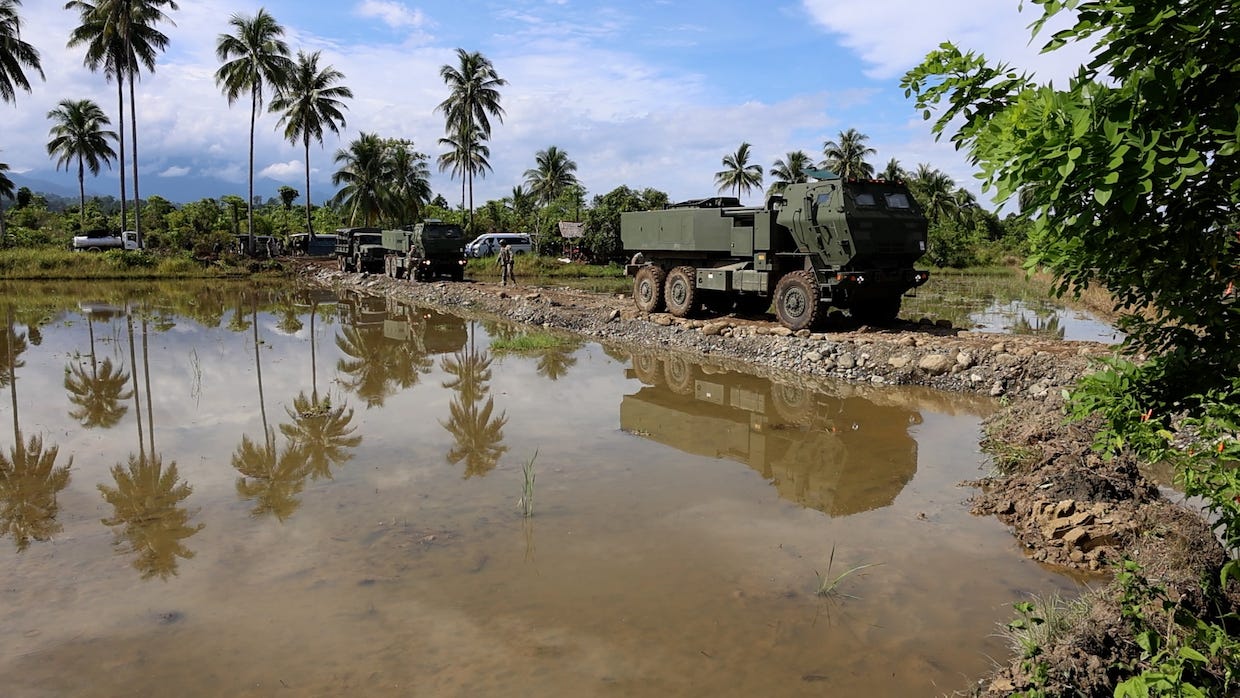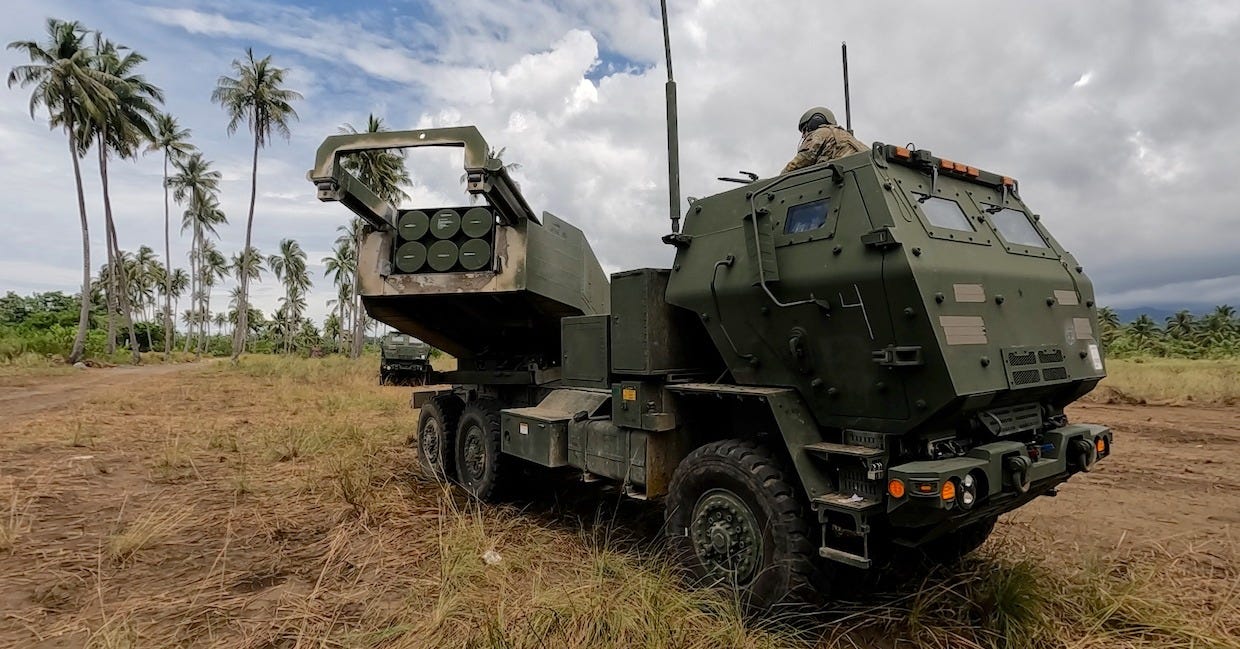HIMARS's high profile on the frontline with China
Across the Western Pacific, militaries are developing and deploying rocket artillery and other long-range weapons.
US and Taiwanese troops fired HIMARS launchers during separate exercises in late April and early May.
The US and its partners are investing in HIMARS and other long-range weapons to counter China’s growing military.
China is assessing ways to counter HIMARS and developing its own rocket artillery as well.
US and Taiwanese troops put the High Mobility Artillery Rocket System, or HIMARS, to the test in late April and early May, demonstrating how it could be used to defend against attacks from the sea.
HIMARS was developed by the US Army two decades ago, but it gained new interest after Ukraine used it successfully against Russia in summer 2022. Since then, the US and its allies have stepped up training with long-range weapons as part of their efforts to counter China’s growing military reach and capabilities. The exercises over the past month show how HIMARS is a key part of those plans.
‘Fast, accurate, and decisive’
The first HIMARS outing came at the annual Balikatan exercise in the Philippines.
During the last week of April, US soldiers loaded HIMARS launchers onto a US Air Force C-130 cargo plane in Subic, northwest of Manila, to fly to Palawan, an island province facing the South China Sea. Upon landing, the launchers were loaded onto an US Army watercraft, which sailed more than 100 miles south to Bataraza. From there, they were driven 50 miles through jungle and urban areas to the coast in Rizal.
In Rizal, US, Philippine, and Australian troops on shore and in boats fired machine guns, artillery, and missiles at floating targets to simulate defending against an amphibious assault. The US soldiers fired six HIMARS shots at pre-designated coordinates in the sea in what their commander called “a realistic training scenario.”

The drill built on training with HIMARS at past Balikatans. In 2023, it was employed for the first “sink exercise” in Balikatan history. (HIMARS is designed for land targets and its shots missed the target vessel, but officials said it was useful training.) In 2024, US soldiers did two HIMARS “rapid infiltration” drills, using trucks, planes, and a hovercraft to transport it to a live-fire drill in Rizal and later flying it to northern Luzon to simulate firing and to practice driving it on local roads to a nearby port.
As in past drills, the HIMARS drill at this year’s Balikatan was meant as training to transport it by land, sea, and air and employ it alongside other weapons and other militaries.
The Philippine military — which plans to buy HIMARS as it shifts its focus to defense against external threats — said afterward that the HIMARS “precision strike” that culminated the drill “highlight[ed] the allied forces’ capability to deliver fast, accurate, and decisive responses to amphibious threats."
‘Full-depth defense’
On May 12, just days after Balikatan ended, Taiwan’s army fired its new HIMARS for the first time. For the test, which took place during an annual exercise and was observed by Defense Minister Wellington Koo, soldiers drove HIMARS launchers into position at a facility on the island’s southern coast. The launchers then fired a total of 33 rockets in several waves.
A “signal error” prevented some launchers from firing simultaneously for part of the exercise, but Lockheed Martin technicians were present to help address the issue. Taiwan’s Defense Ministry credited the HIMARS with “accurately hitting the target area at sea,” and Col. Ho Chih-chung, deputy commander of the Army’s 58th Artillery Command, said it was “an opportunity to enhance our troubleshooting capabilities, allowing us to better demonstrate realistic combat readiness in the event of war.”

Taiwan has ordered 29 HIMARS units since the US authorized sales to the island in late 2020. The first batch of 11 was delivered in November, and Taiwan’s army tested their command-and-control elements in a tabletop exercise in April. The remaining 18 units are expected to be delivered in 2026.
Like its neighbors to the north and south, Taipei is investing in new military hardware in response to threatening activity by China. Beijing claims Taiwan as its territory and has vowed unification, by force if necessary, and its military has become a constant presence around the island. When Taiwan’s army proposed buying an additional 18 HIMARS in late 2022, it said the best way to buy time to respond to an assault on Taiwan’s outlying islands was to use long-range weapons against the attacking forces.
The HIMARS test on May 12 came after a morning exercise with the Thunder 2000, a domestically developed multiple rocket launcher, that simulated a counterattack on an amphibious assault. The Thunder 2000 and HIMARS are “the backbone of artillery firepower,” Ho, the artillery commander, told local media. Ho said the army would make plans based on each weapon’s characteristics to form “a high-low combination to meet the full-depth defense combat capabilities.”
Altering the risk calculus

Those two exercises reflect growing interest among the US and its Pacific allies in being able to mass firepower over long ranges, especially against amphibious assaults and other operations by adversaries around straits and important maritime areas.
The US and Japan have increased training to deploy troops and weapons, including HIMARS, quickly to Japan’s Southwest Islands, which are close to Taiwan and overlook straits connecting the East China Sea to the wider Pacific. Tokyo is building new bases and deploying forces on the islands to better defend them. The US’s 12th Marine Littoral Regiment, which is stationed in Okinawa, would likely deploy to those bases with HIMARS launchers in a conflict.
Japan isn’t planning to buy HIMARS — it is boosting its cruise missile arsenal with domestic models and US-made Tomahawks — but Australia has ordered 42 units. The purchase was announced in early 2023, and since then Australian and US troops have been training to deploying HIMARS long distances to conduct strikes on maritime targets. The first two units were delivered in March and are being fielded with the Australian army’s 10th Brigade. “During my 30 years’ service, I have never personally seen a capability roll-out this quickly,” the brigade commander said in April.
HIMARS’ mobility — it can be loaded on and off a C-130 quickly and be driven about 260 miles on one tank of gas — and its ability to “shoot and scoot” makes it attractive to militaries looking for a weapon that can traverse rough terrain, launch accurate strikes, and dodge return fire. Its suite of munitions adds to its appeal. A single launch canister can fire six GPS-guided rockets with ranges of roughly 50 miles or over 90 miles, depending on the rocket variant. It can also fire a single Army Tactical Missile System, a ballistic missile with a range of about 190 miles. Taiwan has ordered 84 ATACMS, some of which have been delivered, that could reach targets well inside mainland China.

US officials say long-range weapons are vital for being able to disrupt Chinese military movements around Japan, Taiwan, and the Philippines in a conflict. “The ability to deliver fast, accurate, lethal fires across domains is fundamental,” Adm. Samuel Paparo, commander of US Indo-Pacific Command, said at a conference in Hawaii this month.
“To prevent a Taiwan invasion, we don't necessarily need immediate maritime or air superiority in the Taiwan Strait. We just must deny its use to the [People’s Liberation Army] for the use of its aggression,” Paparo said, adding that long-range weaponry from the Army and other service branches “is essential to deny that zone by imposing devastating costs across the PLA.”
The US Army is developing the Precision Strike Missile to replace the ATACMS. The new missile, two of which fit in one canister, has a range of over 300 miles, and future variants are expected to have ranges of up to 1,000 miles. Paparo observed a successful test of it during a sink exercise in Palau last year.
In his remarks this month, Paparo called the new missile “a game-changer that fundamentally alters China's risk calculus.” With ranges from 300 miles to nearly 500 miles “and further,” Paparo said, it "does and will allow us to strike critical nodes within China's anti-access/area-denial bubble — radar sites, missile launchers command centers — potentially neutralizing them before the conflict begins.”
Cross-strait firepower

Chinese strategists are close observers of other countries’ wars, and HIMARS was on their radar before Ukraine began using it against Russia. There is evidence that PLA planners have been assessing its performance in Eastern Europe and thinking about ways to counter it in East Asia.
In a 2023 article, Chinese military analysts outlined offensive and defensive countermeasures, including the use of intelligence-gathering and airpower to “achieve precision strikes” on HIMARS launchers in Taiwan and the use of electronic warfare to undermine Taiwan’s ability to gather targeting data and to interfere with HIMARS’ GPS guidance, as the Russians have done in Ukraine. After reports that the US and Japan were planning to deploy HIMARS to Japan’s Southwest Islands in event of conflict, a Chinese military expert told state media that those islands’ small size would make it hard for the launchers to avoid detection by the PLA.
As China’s military has been thinking about how to defeat HIMARS, it has been deploying a similar capability for itself. The PCH-191, a truck-mounted multiple rocket launcher, was introduced in 2019 and can fire rockets and missiles as far as 300 miles, bringing much of Taiwan into range.
The PCH-191 is “a marked improvement in mobility, firepower speed, and munitions range” over its predecessor, making it the Chinese army’s “most effective cross-strait firepower system,” a US Army War College expert wrote in a 2023 report. The PLA first used it in an exercise in August 2022, after Nancy Pelosi visited Taiwan, but it has been deployed along the coast across from the island and been used in every Taiwan-focused exercise since then, Taiwanese officials told the Financial Times this month.




